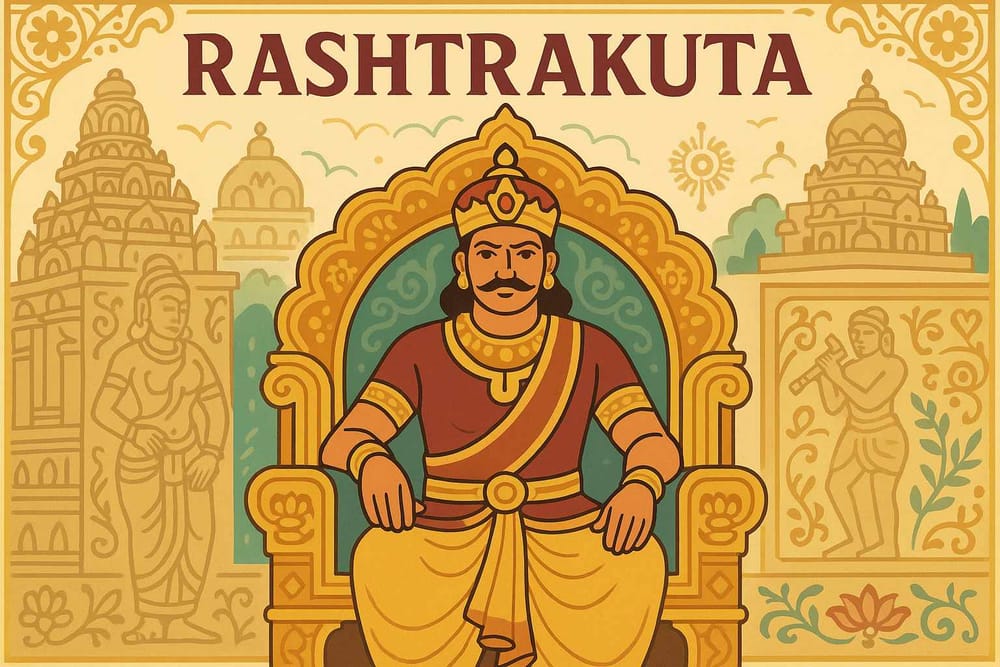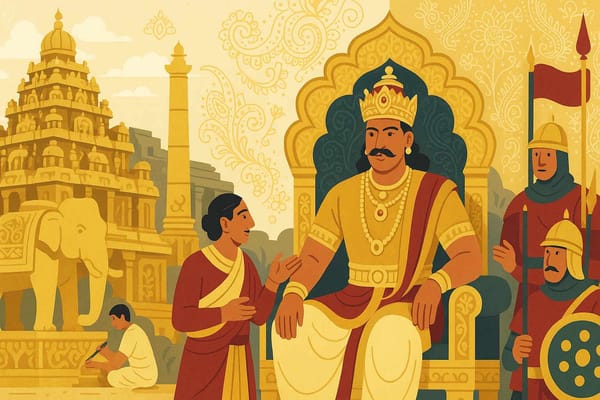
The Rashtrakutas: Explore the Secrets of a Lost Indian Dynasty
Have you ever stood before a piece of history so grand, so magnificent, that it makes you feel incredibly small yet connected to something eternal? That's the feeling one gets when thinking about the Rashtrakuta dynasty. Their story isn't just a chapter in a history book; it's a living, breathing testament to a time when art, spirituality, and power danced together in perfect harmony across the Indian subcontinent. It feels like a story our grandparents would tell, filled with brave kings, divine artistry, and a legacy that continues to echo through the ages.
The Rise of an Empire from the Heart of the Deccan
The journey of the Rashtrakutas began not in a grand palace, but likely among the fertile lands of Lattalur (modern-day Latur in Maharashtra). They were sons of the soil, Dravidian farmers who understood the language of the land. The name itself, from the Sanskrit words 'Rashtra' (country) and 'Kuta' (chieftain), hints at their deep-rooted connection to their people and territory.
In the middle of the 8th century, a visionary leader named Dantidurga saw an opportunity. The mighty Chalukya empire was fading, and he seized the moment, overthrowing their last ruler, Kirtivarman II. This was not just a change of guard; it was the birth of a new era. From this single act of courage, the Rashtrakuta empire blossomed, its influence spreading across modern-day Karnataka, Maharashtra, and Andhra Pradesh. Their rule was marked by a deep understanding of governance, allowing them to manage a vast and diverse kingdom with wisdom and strength.
The Kailasa Temple: Where Gods Descended to Earth
If there is one creation that truly captures the soul of the Rashtrakutas, it is the Kailasa temple at Ellora. Words often fail to do it justice. Imagine not building a temple by laying stone upon stone, but by carving an entire mountain from the top down to reveal a divine abode. It is a masterpiece of 'negative architecture,' a monolithic wonder pulled out of a single, massive rock.
When you stand there, you can almost feel the devotion of the artisans and the vision of King Krishna I, who commissioned this marvel. The temple is more than just architecture; it's a spiritual experience, a representation of Lord Shiva's Himalayan home. Every pillar, every sculpture, every intricate panel tells a story from our ancient scriptures. It’s a powerful reminder of how faith can move mountains—literally. This feat of devotion is similar to how faith has been preserved for centuries in other royal Indian cities, a story you can explore in the living traditions of Udaipur.
A Golden Age of Culture and Coexistence
The Rashtrakuta kings were not just conquerors; they were true patrons of culture and knowledge. Their courts were vibrant hubs of creativity, welcoming poets, philosophers, and thinkers from all walks of life. This was an era of incredible religious harmony, where Jainism, Buddhism, Shaivism, and Vaishnavism flourished side-by-side.
What was the literary legacy of the Rashtrakutas?
One of the brightest stars of this dynasty was King Amoghavarsha I. He was a true 'Rajarshi'—a king with the soul of a sage. His contribution to Kannada literature is immeasurable. He authored Kavirajamarga, the earliest available work on poetics in the Kannada language. It wasn’t just a book; it was a guide that shaped the future of Kannada poetry, setting standards for generations of writers. Under their patronage, Sanskrit literature also thrived, with great scholars producing timeless works.
How did their economy support such grand projects?
The empire's prosperity was the silent force behind its cultural and architectural achievements. The Rashtrakutas were masters of trade, controlling key routes that connected the north and south of India. Their ports buzzed with activity, with ships carrying Indian textiles, spices, and precious stones to faraway lands like Arabia. This economic stability, coupled with a fair taxation system, allowed them to fund magnificent projects like the Kailasa temple and support the arts without burdening their people.
The Fading Light and Enduring Legacy
Like all great empires, the Rashtrakuta dynasty eventually saw its sunset. Around 975 CE, after nearly two centuries of glorious rule, internal conflicts and pressure from rising powers led to their decline. The flame of the dynasty was extinguished, but its light never truly faded. Their legacy is etched in the stones of Ellora, in the verses of *Kavirajamarga*, and in the spirit of religious tolerance they championed.
The story of the Rashtrakutas is a powerful reminder of our rich, multifaceted heritage. They teach us that true greatness lies not just in military might, but in nurturing the soul of a civilization through art, literature, and faith. The tales of their magnificent reign are as inspiring as the stories of courage and devotion found in the history and myths of Udaipur.
Exploring these stories from our past helps us understand who we are. It connects us to our roots and inspires us to carry forward the traditions of wisdom and devotion.
At Bhaktilipi, we are dedicated to bringing these timeless stories and devotional treasures to you. We believe that our heritage is a wellspring of inspiration, and we strive to preserve and share it in a way that resonates with today's world. If you feel a connection to these stories of faith and history, we invite you to explore more on Bhaktilipi.in, a space created with love and respect for our traditions.
A passionate group of people dedicated to preserving India's knowledge of Dharma, Karma, and Bhakti for ourselves and the world 🙏.
Comments
Related in

Rashtrakutas-Explore Ancient India's Powerful Dynasty
Have you ever stood before a creation so grand, so unbelievable, that it makes you question the limits of human hands? I remember the first time I saw pictures of the Kailasa Temple at Ellora. A colossal temple, not built stone by stone, but carved, sculpted, and breathed into life
